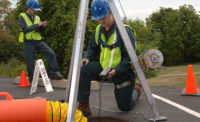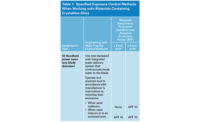OSHA’s confined spaces in construction standard protects employees engaged in construction activities at a worksite with one or more confined spaces. All employers engaged in construction activities have a duty under the standard to make sure their employees do not enter a confined space, except when following the requirements of the standard.
The standard is found at 29 CFR 1926 Subpart AA §§1926.1200 through 1926.1213 —Confined Spaces in Construction.
The presence of a confined space on the worksite triggers this duty. The focus is on the type of work performed, and whether that work could produce, and expose employees to, confined space hazards.
The following 29 CFR 1926 operations are exempt from the confined spaces in construction standard:
• Diving (Subpart Y)
• Excavation (Subpart P)
• Underground Construction, Caissons, Cofferdams and Compressed Air (Subpart S)
Applying the standard
It is obvious that construction employers performing work in a permit space must comply with Subpart AA.
What is less obvious is that the rule also applies when, for example, a manufacturing company is going to use its own employees to perform the work. As always, it is the task being performed that determines which standard to follow. General industry employers must follow the construction rules at 29 CFR 1926, Subpart AA, when performing construction work.
OSHA defines “construction work” as work for construction, alteration, and/or repair, including painting and decorating. This includes the replacement of equipment and structures with upgraded, improved parts. For example:
- Replacing a damaged panel in a confined space,
- Stripping and refinishing the walls in a confined space, or
- Replacing a light fixture in a confined space with an upgraded fixture.
What is left out of the definition of construction work is maintenance. Maintenance work is defined in an OSHA Letter of Interpretation dated February 1, 1999, as “… keeping equipment or a structure in proper condition through routine, scheduled or anticipated measures without having to significantly alter the structure or equipment in the process. For equipment, this generally means keeping the equipment working properly by taking steps to prevent its failure or degradation.”
For example, all the following are considered maintenance activities and are not subject to Subpart AA of 29 CFR Part 1926:
- Inspecting valves in a confined space,
- Cleaning or lubricating equipment in a confined space, or
- Replacing a light bulb in a confined space with the same type of bulb.
Know your confined spaces
A confined space is a space whose configuration and/or contents may present special dangers not found in normal work areas. Confined spaces may be poorly ventilated and, as a result, contain insufficient oxygen or hazardous levels of toxic gases. Working in a tight space can prevent a worker from keeping a safe distance from mechanical and electrical hazards in the space. Fumes from a flammable liquid that is used in a poorly ventilated area can reach explosive levels.
Such hazards endanger both the workers in the confined space and others who become exposed to the hazards when they attempt to rescue injured workers. In a number of cases, rescue workers have themselves died or been injured because they did not have the training and equipment necessary to conduct the rescue safely.
Employer requirements
The standard has specific requirements that are dependent on the type of employer.
All employers
- Identify all confined spaces in which their workers may work and determine whether any are permit spaces. If its workers are supposed to enter permit spaces, the employer is an “entry employer.”
- Employers who are not “entry employers” must make sure their workers stay out of any permit spaces present on the site, unless the workers are authorized for entry.
Entry employers
- Protect workers against permit space hazards by complying with the standard.
- Inform controlling contractor of the program followed and hazards encountered in permit spaces.
Controlling contractors
- Share information it has about permit space hazards with entry employers and other employers whose activities may create hazards in the permit space.
- Coordinate entry operations when there is more than one entry employer.
- Coordinate operations when permit space entry occurs during other activities at the site that might create a hazard in the space.
Host employers
- Share information it has about permit space hazards with the controlling contractor.
Follow the general industry or construction standards?
OSHA developed this standard because of the unique hazards and procedures of confined-space work in construction. Although this final rule is similar to §1910.146, there are differences. That’s why an employer does not have the option of bypassing the procedures that are unique to Subpart AA by complying instead with §1910.146.
However, the differences between §1910.146 and Subpart AA can make it more complicated for employers to comply with two different sets of procedures if they perform maintenance and construction work at the same time in the same confined space. In order to ease the compliance burden on these employers, OSHA will consider compliance with Subpart AA as compliance with §1910.146.
Key differences
The confined spaces in construction standard has requirements that go above and beyond those of the general industry confined space standard. Those include:
- More detailed provisions requiring coordinated activities when there are multiple employers at the worksite. This will ensure hazards are not introduced into a confined space by workers performing tasks outside the space. An example would be a generator running near the entrance of a confined space causing a buildup of carbon monoxide within the space.
- Requiring a competent person to evaluate the work site and identify confined spaces, including permit spaces.
- Requiring continuous atmospheric monitoring whenever possible.
- Requiring continuous monitoring of engulfment hazards. For example, when workers are performing work in a storm sewer, a storm upstream from the workers could cause flash flooding. An electronic sensor or observer posted upstream from the work site could alert workers in the space at the first sign of the hazard, giving the workers time to evacuate the space safely.
- Allowing for the suspension of a permit, instead of cancelation, in the event of changes from the entry conditions list on the permit or an unexpected event requiring evacuation of the space. The space must be returned to the entry conditions listed on the permit before re-entry.
Final thoughts
The confined spaces in construction standard was designed to protect employees engaged in construction activities at a worksite with one or more confined spaces. OSHA’s intent is that all employers engaged in construction activities have a duty under the standard to make sure their employees do not enter a confined space except when the requirements of the standard are met.



